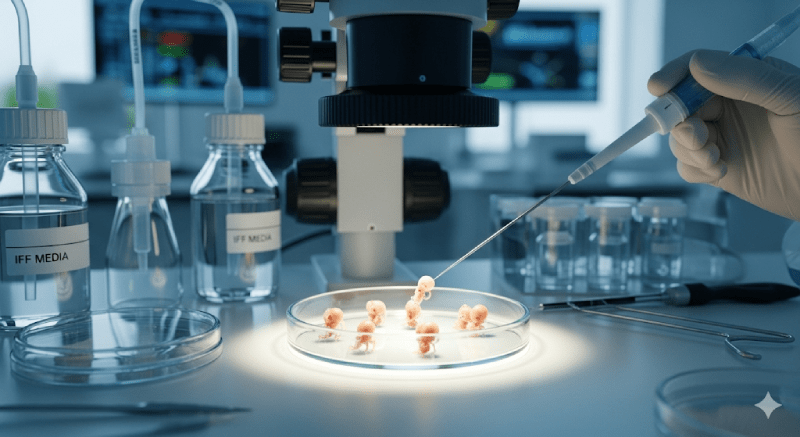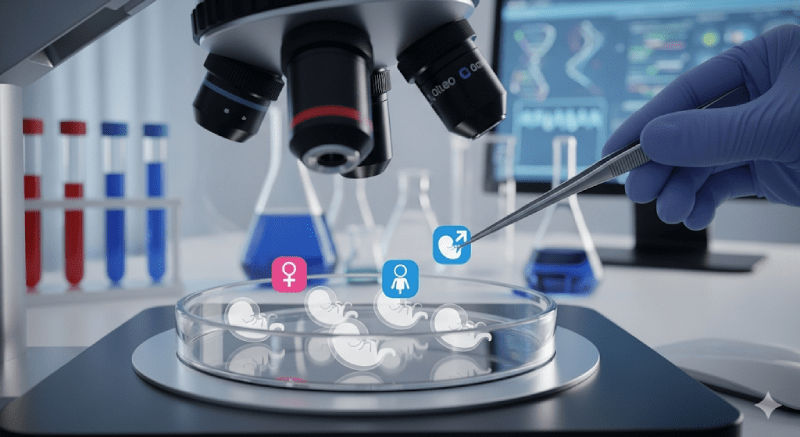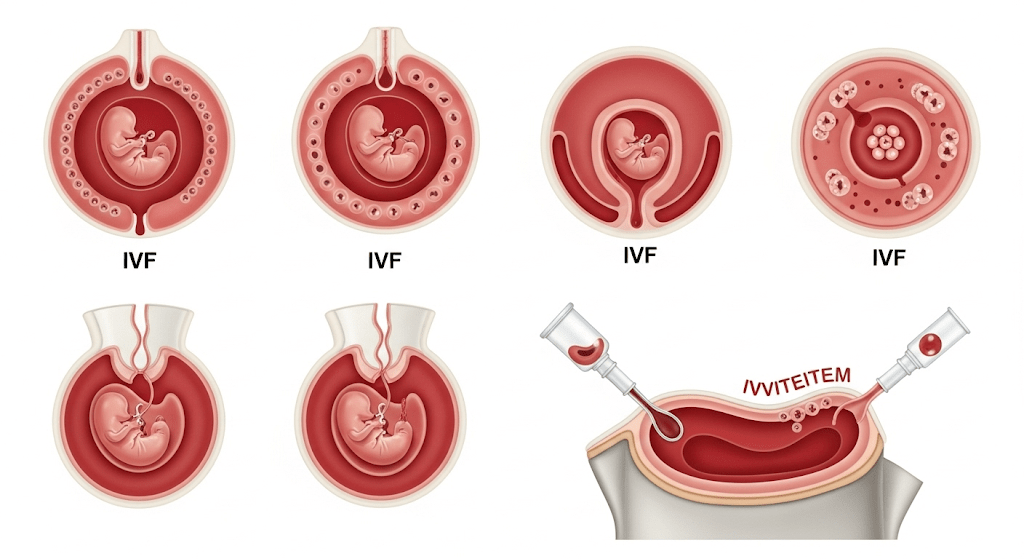What is Gender Selection?
Gender selection is a method generally applied during in vitro fertilization (IVF) treatment. This procedure involves genetically examining embryos to determine their gender and transferring an embryo of a specific gender to the mother’s womb, as desired by the parents.
This method can be chosen by families for various purposes, such as achieving family balancing or preventing genetic diseases. However, this practice also brings with it ethical and legal debates and may not be legal in every country. Therefore, it is of great importance to obtain detailed information about the legal regulations of the relevant country before starting treatment.
Why is Gender Selection Performed?
There are multiple reasons for gender selection. One of the most common reasons is the desire for family balancing; for example, a family with only female children wanting a male child. However, a more important reason is the prevention of gender-linked genetic diseases.
Some genetic diseases like hemophilia are more common in a specific gender. In this case, healthy embryos that do not carry the risk of the disease can be selected to have a baby. This medical necessity makes gender selection practices more ethically acceptable.
Is Gender Selection Legal?
The legal status of gender selection methods varies greatly from country to country. Some countries permit this practice only for medical reasons (preventing gender-linked genetic diseases), while others completely ban it.
On the other hand, in certain countries, gender selection can also be performed for non-medical reasons such as family balancing. For example, in Turkey and many European countries, gender selection is not legal outside of medical necessities. Due to these legal differences, it is highly recommended to seek legal advice before starting treatment.
Can Gender Selection Be Done in Turkey?
In Turkey, gender selection using the in vitro fertilization (IVF) method is legally permissible only when medically necessary, that is, to prevent a gender-linked genetic disease (such as Duchenne Muscular Dystrophy) from occurring in the baby.
Performing gender selection for non-medical reasons, such as family balancing or personal preference, is prohibited according to the laws of the Republic of Turkey. The legal regulations on this matter are quite strict, and centers that perform such practices can face serious sanctions. Therefore, it is essential for couples considering this procedure in Turkey to act in accordance with the law.
How is the Gender Selection Procedure Performed?
The gender selection procedure is performed following a standard in vitro fertilization (IVF) cycle. First, eggs are collected from the expectant mother and fertilized with sperm from the father in a laboratory environment. The resulting embryos are left to develop for a few days. At the stage when the embryos have reached sufficient maturity (usually on day 5 or 6), Preimplantation Genetic Testing (PGT) is performed. During this procedure, a small cell sample is taken from the embryos and the sex chromosomes (X and Y) are analyzed.
What is Preimplantation Genetic Testing (PGT)?
Preimplantation Genetic Testing (PGT) is a method that examines the genetic structure of embryos during in vitro fertilization (IVF) treatment. This test is applied to determine whether embryos carry chromosome abnormalities (PGT-A) or single-gene diseases (PGT-M). When used for gender selection, it analyzes the embryos’ sex chromosomes, allowing for the transfer of embryos of a specific gender. PGT is of vital importance for preventing a genetic disease from being passed on to the next generation.
Does the PGT Procedure Harm the Embryo?
When the biopsy taken from the embryo during the Preimplantation Genetic Testing (PGT) procedure is performed by modern techniques and experienced embryologists, the risk of harm to the embryo is very low.
The laser-assisted biopsy methods used today are designed to protect the integrity of the embryo. The sample taken is a very small group of cells and does not affect the normal development of the embryo. However, as with any medical procedure, the existence of a very small risk should not be forgotten. This risk is minimized in an experienced laboratory.
What Methods Are Used for Gender Selection?
The most reliable and commonly used method for gender selection is Preimplantation Genetic Testing (PGT). This method determines the gender of the embryo before transfer with over 99% accuracy. Apart from PGT, there are less reliable methods such as “sperm sorting,” where sperm is separated based on its gender-determining chromosomes (X and Y). However, the success rates of methods like sperm sorting are quite low and are generally not preferred by the medical community.
How High are the Success Rates?
The success rate of gender selection applications with IVF is directly related to the success rate of the basic IVF treatment. The gender selection procedure (PGT) itself does not have a failure rate; it correctly determines the gender of the embryo with 99% accuracy.
However, the overall success of the treatment, i.e., achieving a pregnancy and it continuing healthily, depends on the age of the expectant mother, the quality of the eggs and sperm, and the overall health of the transferred embryo. The chance of achieving a successful pregnancy can vary between 50% and 60% on average.
What are the Possible Side Effects of Gender Selection?
Since the gender selection procedure is fundamentally a part of in vitro fertilization (IVF) treatment, the side effects are generally those specific to IVF. These can include risks of infection or bleeding during the egg retrieval procedure, hormonal medications that can cause bloating and mood swings.
In rare cases, a condition called Ovarian Hyperstimulation Syndrome (OHSS) may develop. The risk of the PGT procedure itself harming the embryo is very low. It is important to get detailed information from your doctor about these risks.
Can More Than One Embryo Be Transferred?
Transferring more than one embryo in IVF treatment generally increases the risk of multiple pregnancies (like twins or triplets). This situation carries health risks for both the mother and the babies, so practices aiming for a single pregnancy are generally preferred. In cases of gender selection, transferring a single, healthiest embryo of the determined gender is considered ideal. In some cases, the transfer of more than one embryo can be done by a doctor’s decision, but this always carries potential risks.
Is There a Chance of Having Twins or Triplets with Gender Selection?
The chance of having twins or triplets during gender selection depends on the number of embryos transferred. If the couple desires twins and the doctors approve, two healthy embryos of the determined gender can be transferred. However, this situation also brings with it the risks of a multiple pregnancy. Multiple pregnancies are riskier in terms of premature birth, low birth weight, and other complications. For this reason, medical experts generally recommend a single embryo transfer.
What Happens if There Are Not Enough Embryos?
It is a common situation during IVF treatment that a sufficient number of embryos cannot be obtained. This can be due to age, egg, and sperm quality. If a sufficient number of healthy embryos cannot be obtained for gender selection, the procedure may be stopped or the cycle may be repeated.
Your doctor will evaluate whether it is possible to perform the genetic examination of the embryos in this case. A low number of embryos reduces the likelihood of finding a suitable embryo for transfer and can prolong the treatment process.

In Which Cases is Gender Selection Not Recommended?
Gender selection is generally not recommended in certain situations due to ethical and medical reasons. If the expectant mother is of an advanced age and has low ovarian reserve, it may be difficult to obtain a sufficient number of healthy embryos for the gender selection procedure.
In this case, the success rate of the treatment decreases, and it can be financially and psychologically exhausting for the couple. Furthermore, gender selection based on personal preference is not recommended and is not applied in most countries where it is illegal.
What is the Pre-Treatment Preparation Process Like?
The pre-treatment preparation process for IVF treatment and gender selection includes detailed medical evaluations. Couples undergo comprehensive blood tests, genetic counseling, and physical examinations. At this stage, the expectant mother’s ovarian reserve and uterine health, and the father’s sperm quality are evaluated. If there is a risk of a gender-linked genetic disease, special genetic tests are performed for this disease. Following all of the doctor’s recommendations before starting treatment is crucial to increasing the chance of success.
Should I Get Genetic Counseling Before Starting Treatment?
Yes, it is highly recommended that every couple considering gender selection with IVF gets genetic counseling before starting treatment. A genetic counselor evaluates the genetic risks carried by the family and explains their relationship to gender. They also provide detailed information on how effective genetic screening (PGT) methods are and how the process works. This counseling helps couples make informed decisions and start the treatment process better prepared.
Does Gender Selection Have Psychological Effects?
The gender selection process can have significant psychological effects on couples. High expectations, failure to find an embryo of the desired gender, or treatment failure can lead to disappointment. This process can cause tension between couples. For this reason, getting psychological support before and throughout the treatment process is very important. Psychological counseling can help couples cope with stress and manage the treatment process in a healthier way.
Is There a Chance the Desired Gender Might Not Be Achieved with Gender Selection?
The Preimplantation Genetic Testing (PGT) method used for gender selection determines the gender with over 99% accuracy. Therefore, the possibility of the desired gender not being achieved is almost non-existent. However, PGT requires an experienced laboratory and expert team to provide accurate results. In rare cases, situations such as a technical error during the biopsy or the embryo being mosaic can lead to a wrong result. These situations are very rare and advanced laboratories try to minimize such risks.
What are the Ethical Dimensions of Gender Selection?
Gender selection, especially when done for non-medical reasons, leads to serious ethical debates. Many ethicists and biologists argue that this practice turns babies into “designer” products and threatens the diversity of human nature. These views have paved the way for legal restrictions on gender selection practices. Gender selection done for medical reasons, on the other hand, is generally considered more acceptable for the purpose of preventing genetic diseases.
How Safe are Gender Selection Methods?
PGT, the safest method for gender selection, is a technology that has been used for decades and its reliability has been proven. This method is very effective in determining gender as well as checking the genetic health of the embryo. The PGT procedure is performed with minimum impact on the normal development of the embryo. However, like any medical procedure, PGT also carries a very small risk. These risks are minimized in the right hands and under appropriate laboratory conditions.
Is There an Age Limit for Gender Selection?
Although there is no specific age limit for gender selection, the expectant mother’s age significantly affects the success rate of the treatment. Advanced age (generally 40 years and older) can lead to a decrease in egg quality and quantity.
This reduces the likelihood of obtaining a sufficient number of healthy embryos for the gender selection procedure. Therefore, doctors usually inform older women about the success rates of this method and can offer alternatives.
Can Genetic Diseases Be Prevented with Gender Selection?
Yes, the Preimplantation Genetic Testing (PGT) method used for gender selection is highly effective in preventing gender-linked genetic diseases from occurring in the newborn baby. For example, diseases like Hemophilia are seen in male children, while in X-linked inherited diseases, female children can be carriers.
In these cases, selecting and transferring healthy embryos prevents the disease from being passed on to the next generation. This is the most important medical justification for the method and forms the legal basis in many countries.
How Long Does Gender Selection Treatment Take?
The gender selection procedure is part of a normal IVF cycle and the total process usually takes 4 to 6 weeks. This period includes all stages from the use of hormonal medications to egg retrieval, fertilization, and monitoring embryo development. The genetic examination (PGT) process can take a few days. The waiting period until the pregnancy test after transfer is also included in this period. This duration can vary depending on the individual’s medical situation.
Is Gender Selection Treatment Painful?
Gender selection treatment is fundamentally a part of IVF treatment, and minimal pain may be felt during the procedure. Since the egg retrieval procedure is usually done under sedation or light anesthesia, patients do not feel any pain at this stage. Mild cramping or bloating may occur after the procedure. Embryo transfer is a completely painless procedure and does not require anesthesia. Overall, the treatment process is painless and comfortable.
What is the Chance of Getting Pregnant After Gender Selection?
The chance of getting pregnant after a gender selection procedure is the same as the general success rates of basic IVF treatment. This rate depends on the expectant mother’s age, egg and sperm quality, the health status of the selected embryo, and uterine health. The chance of pregnancy is higher in young, healthy women, while this rate may decrease in advanced age. Your doctor will inform you about an estimated success rate based on your personal situation.

What are the Societal Effects of Gender Selection?
Gender selection is a major topic of debate due to its potential to cause societal gender imbalance. Some critics argue that this practice could lead to a preference for a specific gender (usually male) in society, which could increase gender imbalance. This situation could lead to a decrease in the female population relative to the male population in some countries, resulting in various social problems. Therefore, many countries have imposed strict rules on this practice.
Is the Method Only Applied to Those with Infertility Issues?
No, gender selection is not only applied to couples with infertility issues. In countries where it is legally permitted, couples who do not have an infertility problem but want to achieve family balancing or carry a risk of genetic disease can also use this method. However, it should be noted that since this procedure requires standard IVF treatment, it may not be suitable for every couple. The process can be particularly challenging for women with low ovarian reserve or men with sperm quality problems.
What Should I Do If My Gender Selection Treatment Fails?
It is natural to feel disappointed if your gender selection treatment with IVF fails. First, it is important to have a detailed discussion with your doctor to understand the reasons for the failure. Your doctor may suggest changes to the treatment plan for the next attempt.
Getting psychological support during this process is also important. It should not be forgotten that a single failed attempt does not mean that a successful pregnancy cannot be achieved in the future. Many couples are able to have a baby after multiple attempts.
Is an Unwanted Gender Possible with Gender Selection?
The PGT method used for gender selection ensures that the desired gender is determined with over 99% accuracy. Therefore, the possibility of the genetically determined embryo’s gender being incorrect is almost non-existent. However, in rare cases, situations such as a technical error during the biopsy or the embryo being mosaic can lead to a wrong result. These situations are very rare, and advanced laboratories try to minimize such risks.
What Documents are Required for Gender Selection?
If you have a medical reason for gender selection (a gender-linked genetic disease), your doctor will ask for genetic test results to prove the disease. For treatment, every couple needs to provide standard documents such as a marriage certificate and identification information. In some countries, documents showing that the couple has received genetic counseling before starting treatment may also be requested. It is important to get detailed information from your doctor or clinic about all the required documents.
How are Gender Selection Prices Determined?
Gender selection prices are determined in addition to the cost of basic IVF treatment. The main reason for this additional cost is the genetic examination (PGT) procedure of the embryos. Prices vary according to clinics, countries, and the number of embryos to be examined with PGT. Some clinics offer package prices, while others charge separately for each stage. You can get the most accurate information on this matter from the clinic where you plan to have the treatment.
Are There Gender Selection Methods Other Than IVF?
Although various natural methods (diet, timing) or sperm sorting methods are suggested for gender selection, these methods do not have scientific validity or high success rates. The only scientifically proven and reliable method is the Preimplantation Genetic Testing (PGT) method applied with IVF. Other methods are based on personal preference and do not guarantee the desired result. Therefore, the most reliable way is PGT.
How Do I Apply for Gender Selection?
Applying for gender selection starts just like a standard IVF treatment. First, you need to contact an IVF clinic to schedule an initial consultation. In this consultation, your medical history is evaluated, and your suitability for treatment is determined. If there is a risk of a gender-linked genetic disease, this must be proven. When you apply to the clinic, you will be given detailed information about the entire process, and the necessary documents will be requested.
How Does Gender Selection Affect the Baby’s Health?
Since the PGT method used for gender selection also examines whether the embryo is healthy, babies born with this procedure are more likely to be genetically healthy. PGT helps detect chromosomal abnormalities and some genetic diseases. This can have a positive effect on the overall health of babies born through gender selection. However, other factors that can affect the baby’s health during and after pregnancy are always present.
Which Centers Should I Choose for Gender Selection Treatment?
It is very important that the center you choose for gender selection treatment has an experienced and expert team. You should get information about the clinic’s technological infrastructure, laboratory quality, and previous success rates. Also, you must ensure that the center operates in accordance with the law. Centers that offer pre- and post-treatment support services and adopt a patient-centric approach should be preferred. You can get this information by visiting the clinic or doing research online.
How Should I Make the Decision on Gender Selection?
The decision on gender selection is a complex process with both medical and ethical dimensions. When making this decision, you should evaluate whether you are emotionally and financially ready for this process as a couple. If you have a reason for gender selection (e.g., a risk of a genetic disease), you should make an informed decision by getting genetic counseling. When making your decision, it is important to consider not only your personal preferences but also ethical and legal boundaries.
Pros of IVF Gender Selection:
- Medical Reasons: Some couples choose gender selection for medical reasons, such as a genetic condition that affects only one gender. If the couple has a high risk of having a child with a genetic condition that affects only one gender, they may choose IVF gender selection to ensure their child is born without the condition.
- Family Balancing: Some families choose gender selection for family balancing purposes. For example, if a couple has three boys and want to have a girl, then they might choose gender selection to increase their chances of having a girl.
- Psychological Reasons: For some couples, gender selection can be psychologically beneficial. For instance, if a couple is struggling to overcome infertility, gender selection can give them a sense of control over their reproductive destiny, which can be an empowering experience.
Cons of IVF Gender Selection:
- Ethical Concerns: Many people, including some ethicists and religious leaders, are critical of gender selection because they view it as unnatural or suggesting that one gender is more desirable than the other. They argue that natural selection determines the gender of their child, and that gender preference imposes unrealistic expectations about the child and their future abilities.
- Limited Choices: IVF gender selection technology is only offered by a limited number of IVF clinics for medical and family balancing purposes. Since it is a new and evolving technology, it also means that not everyone has equal access to it even if the cost is prohibitively high.
- Miscarriage Possibility: There is a slightly higher risk of miscarriage when having an IVF pregnancy compared to natural conception. Couples considering IVF gender selection should be informed about this increased risk.
The creation of IVF and assisted reproductive technology has been cited as one of the greatest feats of clinical and scientific advancement over the past century, if not ever. It would be difficult to find anyone among the millions of people who have benefited from IVF who would disagree. The ability to select the gender of your newborn was once thought to be impossible, but IVF and other assisted reproductive technologies have changed that. But should IVF be used for sex selection, or goes IVF’s “family balancing” too far? Let’s look more closely.

PGT-A is the only procedure that can be used by those who want to choose the gender of the baby in permissible countries?
The PGT-A area leads an area in terms of reliability and accuracy, however there are a number of different strategies to develop some efficient ways to determine your baby’s gender.
Flow cytometry, also referred to as “sperm sequencing,” is one of the more popular technologies used in IVF facilities to help gender selection. This method involves mixing a vibrant paint with a sperm sample and has an accuracy rate of 80% for some claims. The degree to which the genetic material on the sperm is coupled to the paint can distinguish the child from the girl. A costly technique with many indicating lower accuracy figures may be another caution.
IVF sex selection – where it is allowed?
There are a variety of reasons why someone would need or desire to choose sex. Finding a facility that offers genetic testing of embryos and records the sex of the embryo(s) on the test findings is, for the majority, the simplest method to go about doing this. Where then is this feasible?
There are national variations and opportunities, and these are based on intricate ideas of morality, law, and ethics; sometimes these variations are obvious, sometimes not, as the examples below demonstrate.
- In certain nations, it is against the law to choose a baby’s sex, yet there are no particular restrictions on clinics. This is true in nations like Ukraine or Russia, thus in actual practice, clinics might provide the data with test results.
- The findings of a PGT-A test should not reveal the sex of an embryo in some nations where legislation is supported by regulatory authority recommendations (such as a national fertility body). Countries like Spain and Portugal are affected by this.
- In some nations, the information that can be listed in PGT-A findings is not subject to specific legislation, although clinics are advised not to allow patients to choose the gender of the embryo by the relevant national regulatory body. a rise in reproduction This implies that the clinic may amend the regulations governing this on a clinical basis.
In some nations, the information that can be listed in PGT-A findings is not subject to specific legislation, although clinics are advised not to allow patients to choose the gender of the embryo by the relevant national regulatory body. a rise in reproduction This implies that the clinic may amend the regulations governing this on a clinical basis.
The Most Successful Ivf Gender Selection In The World
IVF is one of the most preferred fertility methods. Gender Selection is a preferred method for family balance. IVF Gender Selection is not possible in every country. For this reason, patients prefer countries where they can receive treatment. Cyprus is the first among these countries. Cyprus fertility centers will offer you the IVF Gender Selection method. You can also make cistegins in Cyprus IVF centers, and you can get high treatment treatment.
Is IVF Gender Selection legal in Cyprus?
The only nation in the world to make gender choosing through PGD legal is Cyprus. Our experts have extensive expertise in IVF treatments and gender selection using PGD, as well as years of experience. Our experts are committed to assisting you in having the healthy child you desire. The mother may need to stay at the Cyprus IVF center for at least a week (7 days) in order to complete the PGD process, which may acknowledge that stimulation and monitoring have already been completed at home. The IVF Center’s guest relations staff will make sure you are completely at ease and comfortable during your stay. The only treatment that still achieves gender selection success rates above 99.9% is PGD.
Gender Selection in Different Countries
The cost of gender selection can vary significantly depending on a number of variables, including the location where it is being done, the quantity and quality of IVF cycles and embryo transfers, and the mother’s health.
Gender Selection in USA
In the USA, gender selection IVF procedures typically cost between $15,000 and $300,000. The cost may change depending on the patient’s needs and the area. Before having a healthy pregnancy and birth, so many couples must go through numerous IVF gender selection cycles, which can greatly increase the overall cost.
Gender Selection in Mexico
Because to its shared border with the United States and less expensive healthcare than in the United States, Mexico is one of the most preferred countries for IVF gender selection. In this nation, sex selection costs about $8000. Individuals who are set on traveling to Mexico for IVF gender selection should think about the costs associated with staying for the entire procedure, which can take three weeks or longer. The price of travel, lodging, food, and intercity transportation are all included in these costs.
Gender Selection in Russia
Only people with a history of sex-related genetic abnormalities running in their family and who can produce the necessary medical evidence can choose their gender legally in Russia. In Russia, gender selection typically costs about $2500 more than IVF, which can cost anywhere from $3000 to $5000.
Gender Selection in Thailand
Thailand may be an alternative for people who live in nations where sex selection is prohibited to acquire this service legally and successfully give birth to a kid with the desired sex. PGD gender selection is available in Thailand at an average price of $15,000 per procedure. IVF gender selection is frequently less expensive in Thailand than it is in western nations like Europe, Australia, or North America.



